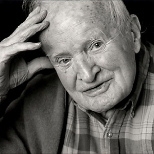Institute Professor Emeritus Arthur Robert von Hippel, who fled to the United States from Nazi Germany and went on to become a leader in the field of materials research, died on Dec. 31, of complications from flu. He was 105 years old.
His name graces the highest international honor awarded in his field. The von Hippel Award of the Materials Research Society has been presented annually since 1976; von Hippel himself was the first recipient.
His son, Professor Eric von Hippel of the Sloan School of Management, said his father cross-country skied until he was 95 and continued to exercise by walking a mile a day even into his 100s.
"A few years ago during a hurricane, he insisted on going outside in the wind and rain," Eric von Hippel recalled. "So we went out and the trees were crashing down around us, and he thought it was terrific."
Born in Rostock, Germany, on Nov. 19, 1898, the elder von Hippel was trained as a physicist, earning the Ph.D. from the University of Gottingen in 1924. Before coming to the United States, he taught at the University of Istanbul and the University of Copenhagen, where he worked with Nobel laureate Niels Bohr. He was married to the former Dagmar Franck, daughter of Nobel Prize-winning physicist James Franck, for more than 40 years. Mrs. von Hippel died in 1975. The von Hippels were longtime residents of Weston, Mass.
After fleeing Germany, von Hippel was invited to MIT in 1936 by Karl Taylor Compton to be what von Hippel described as the "physicist in the electrical engineering department." As an assistant professor and one of the first people to understand the molecular structure of materials, he founded the Laboratory for Insulation Research (LIR) in 1940 to study the electrical properties of materials. He became professor of astrophysics in 1947 and an Institute Professor in 1962.
His lab was involved with the effort to develop radar for the Allies during World War II, in conjunction with MIT's Radiation Laboratory in Building 20. The Table of Dielectric Materials he compiled during that period remains the standard today. For this table and his work in developing the techniques and instrumentation needed to make the measurements it contains, von Hippel received the President's Certificate of Merit in 1948, the second-highest honor given a civilian in this country.
When Sputnik was launched in 1957 ("the little satellite circles like an embarrassing fly over the heads of the free world," von Hippel said), he urged researchers to develop more reliable materials. "To prevent the next war," he wrote in 1958, "we have to buy not quantity but quality and extreme reliability, and these we can do only through modern materials research."
Von Hippel often treated his MIT students to one-on-one conversation over tea and cookies, sometimes in lieu of a traditional written exam. Markus Zahn, now a professor of electrical engineering at MIT who in 1969-70 took von Hippel's two-semester course "From Atoms Toward Living Systems," remembered the experience fondly when von Hippel turned 100 in 1998.
"As part of the course work, I used to meet weekly with von Hippel to discuss physics. His longtime secretary, Aina Sils, served cookies and tea. His lectures included many slides," Zahn recalled. "Occasionally a slide of personal history would slip in, such as a picnic scene with a dignitary such as Albert Einstein. Then Professor von Hippel would tell us some anecdote...
"He was an extremely well-known professor when I was a student here. When you took his course, you took it not only for the technical knowledge he'd give you, but also for the anecdotes about the people he knew. Each day you'd go to class wondering who he'd show that day."
On his father's 100th birthday, Eric von Hippel remembered how his father influenced his career choice and reminisced about his own childhood experiences at MIT.
"I attribute the fact that three out of five of my father's children became professors to his method of sharing his own excitement with work and life. Dad would bring me to MIT and I would run up and down the corridors with my sidekick, Zachary Wiesner. We'd stick our heads into offices and people would just invite us in," said Eric von Hippel, a member of the fifth generation of von Hippel professors.
In addition to Eric, von Hippel is survived by three other sons, Peter of Eugene, Ore., Arndt of Anchorage, Alaska, and Frank of Princeton, N.J.; a daughter, Maianna of Needham, Mass.; 11 grandchildren and seven great-grandchildren.
A memorial service will be scheduled at MIT. Funeral services were private.
A version of this article appeared in MIT Tech Talk on January 14, 2004.






